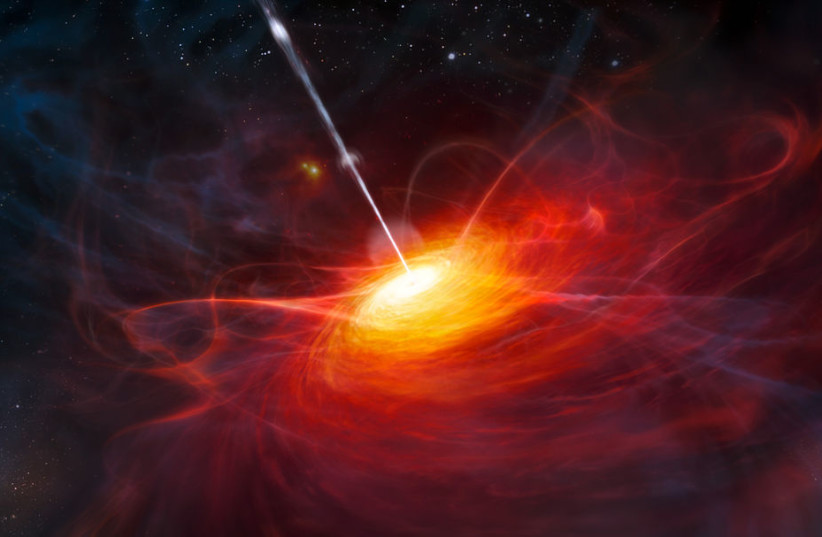Scientists have found what may be the single brightest object in the known universe: A gigantic quasar, growing at a record-breaking pace as the black hole powering it grows as much as one Sun per day, according to a recent study. In other words, the scientists have also discovered the fastest growing black hole in existence.
This research, made possible by the European Southern Observatory's (ESO) Very Large Telescope (VLT), was led by astronomer Christian Wolf of the Australian National University (ANU)
The findings of this study were published in the peer-reviewed academic journal Nature Astronomy.
A bright black hole? What is a quasar and why is this one so big?
Quasars are some of the brightest things in existence. They are powered by black holes, which are huge concentrations of gravity that don't let anything, not even light, escape, rendering them invisible.
This may seem contradictory, but complex astrophysics tends to be rather complex.

Black holes are indeed massive concentrations of gravity that pull everything into them, including light, rendering them invisible. Then there are even larger versions called supermassive black holes, and one exists in the heart of most galaxies, including our own Milky Way, which is home to the supermassive black hole Sagittarius A*.
A quasar is the core of a galaxy that is especially bright, and that brightness is fueled by the supermassive black hole. This is because while the black hole itself is invisible, the act of it consuming matter isn't.
Black holes are surrounded by an accretion disc, which is filled with gas and minerals that it ends up devouring, growing bigger as everything that comes close to it gets ripped apart. All the material in the disc creates friction and gravitational stress as it tumbles to the event horizon, the point of no return in the black hole's grasp. All this friction and stress translates into energy.
It should be noted that not all supermassive black holes fuel quasars - Sagittarius A*, for instance, does not. There are a number of reasons why, but it ultimately boils down to not all galaxies having active galactic nuclei (AGNs). Certain factors can indeed trigger the start of quasars, should there be enough matter in the accretion disc. One such possible phenomenon that could trigger this is galaxy mergers, when different galaxies merge together, pushing more matter towards the supermassive black hole.
Scientists have known about the existence of quasars since 1963, when researchers found what they thought was a bright star only to realize that it was so far away that it must have had some immense energy fueling it.
In the decades since, around a million quasars are now known to exist, though they remain a subject of scientific curiosity.
With that out of the way, lets look at the quasar that is the focus of this article.
Shine bright like a quasar: The brightest light in the cosmos
The quasar in question was identified as J0529-4351, and in terms of brightness, it quite literally outshines everything else, being over 500 trillion times brighter than the Sun.
How is this possible? The answer is the accretion disc that fuels the quasar, which is believed to be seven light years in diameter.
To put that in perspective, that would be like traveling from the Sun to the planet Neptune 15,000 times.
But all of this raises a big question: If this is quite literally the brightest thing in existence, why have we only just discovered it?
Well, there are a few reasons.
First, there's distance. J0529-4351 is located so far away from Earth that it would have taken over 12 billion years for its light to reach astronomers.
Secondly, it technically was discovered earlier. According to co-author Christopher Onken, J0529-4351 was visible in ESO images since 1980. However, no one knew it was a quasar, mistaking it for just a regular star.
The reason for this is that it is surprisingly much harder to find a quasar than one would think.
Datasets are analyzed by machine-learning models to sift through data to identify quasars. This is limited though by existing data. Quasars are judged based on the metric of previously known quasars, so anything that doesn't match that data wouldn't be seen as such.
To put it simply, this quasar is so much brighter than other quasars that astronomers' machine-learning models could not recognize it as one. Instead, it was thought to be a star much closer to Earth.
It wasn't until 2023 that scientists were able to recognize it as a quasar, and further observations and data collection realized that it was the single brightest quasar ever found, as well as the fastest-growing black hole.
Further research will delve into this black hole in order to study its growth, since some of the many mysteries of the universe hinge on how these black holes and galaxies form. Recent studies have even cast doubt on long-held beliefs about their formation, indicating that black holes may have existed far, far earlier than previously believed.
According to lead researcher Wolf though, there's another reason he's looking to study black holes: "Personally, I simply like the chase."
